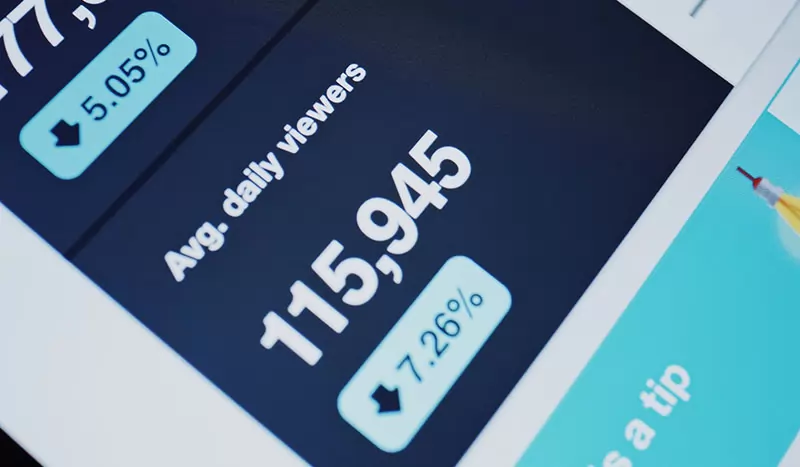Table of Contents
- What is Digital PR
1.1 What is the difference between digital PR and traditional PR? - What are the benefits of digital PR?
- How do I create a strong digital PR strategy?
- How do I come up with good ideas for digital PR campaigns?
- How do I reach out to journalists?
- How do I measure the success of digital PR campaigns?
The Definitive Guide to Digital PR
- 70% of links search users click on are organic (DSIM)
- Journalists receive, on average, 50-100 press releases every week. 44% prefer to receive them in the morning. 68% just want the facts. (Business 2 Community)
- 64% of journalists say they prefer that follow-up on pitches to be done by email rather than phone, (Business 2 Community)
- 76% of journalists say they feel pressure to think about their story’s potential for sharing on social media. (Business 2 Community)
- The first position on Google search results on desktop has a 34.36% clickthrough rate. On mobile it’s 31.35%. (Hubspot)
1. What is Digital PR?
Digital PR is a term being used more and more frequently in digital marketing. If you are unsure on exactly what it means, you’re not alone. While most of us are ok with the PR bit, many of us are unclear on the term as a whole.
To understand what digital PR is and how it works, it is important to understand where it departs from traditional PR. Same objective, different tactics. While both aim to enhance the client’s reputation and increase brand awareness among target audiences with the ultimate goal of increasing sales, their approaches to content and interaction with those audiences are leagues apart.

1.1 What is the difference between digital PR and traditional PR?
To get a bit of context, it’s worth looking at the people working in the industry. Today’s PR pros have often travelled one of two career paths.
The first group come from a traditional PR background. Pre-digital revolution, this group began their careers offline – focusing on crisis and reputation management and promoting brand awareness via a network of lifesaving contacts in their niche built up over many years. Then the digital revolution came along and changed everything. Although traditional PRs are used to dealing in print, today they are usually happy to negotiate coverage on relevant websites and dabble in social media, influencer marketing and any other discipline that will benefit their client.
The second are those from SEO backgrounds who opted for a career in optimised content strategy, rather than the more technical side of SEO. Having survived the 2011 Penguin update, this group learned early on that while content is king, success is measured according to a complex system of factors and metrics.
Digital PR represents where the two strands of the discipline have started to blur into one another. Digital PR specialists develop strong content with a unique hook or angle that journalists will be interested in and combine it with SEO strategy – optimising the content to tick all the relevant search boxes.
The content in question could be an article, an infographic, survey data, video, interactive content – anything you think the gatekeepers of top-tier sites will be interested in. Buzzfeed-style ‘listicles on average receive 74% more links than any other content type.
Content you might like:
“In reality, one could say that digital PR is just traditional PR expanded and eventually onsite and offsite PR will be covered by the same term.”
Sometimes called link-building, digital PR is essentially a strategy. It involves applying the principles of PR to digital content – creating content with a unique angle or hook and outreaching to bloggers and journalists in order to get coverage (and therefore links) on relevant websites.
This seems simple – and in theory, it is. The greatest difficulty comes from nailing both a killer angle and a sharp strategy.
2. What are the benefits of digital PR?
The benefits and payoffs that come with a strong digital PR campaign are not to be sniffed at. All of these following benefits work together to help you grow your business and extend the reach of your brand online:
Generates relevant links from credible sources and sites
When respected sites reference you as a source, people come to see you as a credible source of valuable information – and so does Google.
Improves search ranking score
We know that Google penalizes sites that gain backlinks in shady ways and rewards those that gain them naturally. While it is the prerogative of our search overlord to change its rules and algorithms at any time, one thing you can count on is that it will always favour sites that it recognises as publishers of valuable, quality information.
Creates links that are earned – not paid
Helping Google, audiences and potential customers identify your brand as an industry player and thought leader, rather than a newbie or amateur willing to pay for eyeballs. This in turn …
Boosts your brand reputation and identity
In the same way that any good content marketing does. Audiences appreciate that you are prepared to invest in research and good storytelling.
Increases traffic
As other sources with their high domain authority and huge audiences link back to your content, you’ll receive a greater number of visitors to your site.
Content you might like:
Generates social shares
Good stories prompt people to share on social media. This boosts the online profile of your brand, prompting even more traffic to flow your way.
Influences purchases
This isn’t the aim of a digital PR campaign, but it can be a welcome side-effect. Some content naturally conveys key messages and USPs to potential customers – just make sure it isn’t the focus. Journalists won’t touch anything salesy with a bargepole.
Inspires brand loyalty
By helping brands build good relationships with consumers through content.
Provides a tangible way to measure success
Digital marketing allows you to track almost every aspect of interaction success. This can help you identify what works, helping you craft better campaigns in the future. Tools like Google Analytics help you keep track of how your campaign is performing.
Is a cost-effective strategy
A campaign doesn’t have to cost the earth to be a success. Get it right and the thing will pay for itself in web traffic and conversions.
3. How do I create a strong digital PR strategy?
Whatever the nature of your campaign, you will find that an effective strategy usually requires the following steps.
Identify content goals
As with any strategy, it’s best to start with your objectives. In digital PR, this means looking at your content/ campaign objectives and how they fit in with your company objectives and business plan as a whole.
Some examples of digital PR or content objectives:
- Boost traffic to homepage
- Boost traffic to a particular product page
- Raise overall brand awareness
- Boost social following
- Spotlight on new products
- Highlight USP
IMPORTANT! Yes, the content you create should be in keeping with brand values but remember who you’re creating it for. Most journalists won’t touch anything with obviously branded or salesy. Creating something with a unique angle or hook is 100% more important than creating something your brand likes.
If you are looking to drive traffic to a particular product page, you might want to brainstorm content ideas loosely related to that product. If you are looking to raise overall brand awareness you might want to look at pulling the digital equivalent of a ‘PR stunt’ to get attention.
Create a schedule
Who needs to sign off what and when? The schedule will vary from business to business and from campaign to campaign. Put milestones in place and make sure there is accountability. Everyone knows what their role is and when they need to act.
Create personas
Who are you going to be targeting with your content? What kind of journalists or bloggers? What kind of audience niches? More on this below.
Ideation
This is undoubtedly the hard bit. We’ll discuss this a bit more in section 4 – but the key is to be prepared to invest a generous portion of your time and budget in coming up with the goods. The internet is saturated with content – to shine you’ll need something beautiful, useful, interesting or with a bit of an edge.
Research
Once you have the seed of a good idea, it’s time for some desk research. Research can help you see which of your ideas has most ‘legs’. You might find that someone else has already covered your idea, in which case you might need to change the angle. You might find that the data needed for the content simply doesn’t exist, in which case you might want to commission a bespoke survey. If the idea is good, your research should be exhaustive. You don’t want to spend weeks working on a campaign only to find that someone else got there first (and possibly did it better).
Content creation
Self-explanatory – just sharpen that angle wherever possible and remember your target audience every step of the way.
Outreach
This is the other hard bit. Unlike the other steps in the process, you will be battling forces beyond your control. Necessary tools = patience, persistence and a thick skin.
Our digital PR campaigns are guaranteed to generate relevant, authoritative links to improve your SEO
Whats more, as a digital PR agency, we manage the whole process, from developing unique angles and creating the content to outreaching to journalists.
No risk. No fuss. Just guaranteed links.
Let’s talk about your digital PR requirements
Get in touch or call 0161 791 4055.
4. How do I come up with good ideas for digital PR campaigns?
Packaging your content in the right way works, promoting it innovatively helps but it will all be for nothing if the angle doesn’t work. Finding a strong, unique angle may take time, more time than any other part of the process, but it is time well spent.
The ideation process will be based on your objectives. If the objective is to raise brand awareness, you may want to brainstorm content ideas around your USP. If it is to drive more traffic to a particular product page.
Identify trending topics
Social media is great for helping you keep a handle on what’s trending but you may also need help from Google Trends and a tool like Buzzsumo – enter a couple of keywords and it will show you what content has been shared the most.
Desk research
Find out what else is out there, look for interesting data and spot potential gaps you can fill in with your content.
Brainstorm
Start this process independently, jotting down ideas based on your research. Once you’ve got a couple with potential, assemble your team – even those not usually involved in the content-producing process and try out some new brainstorming techniques. Our current favourite is the ‘hat’ or parallel-thinking method.
Create personas
Create a persona or two, not only for audience niches but also for the types of journalists and blogger you will be targeting. To state the obvious, if you don’t get the coverage, audiences won’t get the chance to look at it.
Based on your audience and journalist personas, aim to come up with three niches the content might be relevant to.
Run some pre-outreach
If you’re feeling unsure about an idea, there’s nothing stopping you contacting your target journalist to see whether they’d be interested.
Content you might like:
EXAMPLE Burger King recently ran a campaign in association with NoBully.org. The video content shows restaurant employees serving ‘beaten up’ burgers to customers. It compares the proportion of the customers that complained (95%) to the proportion of the same customers that complained or tried to intervene when a high school kid was bullied (12%). The message here is clear – many of us are prepared to look the other way unless a problem affects us directly.
If we were brainstorming the outreach process for this story, we could start by identifying three niches that would be interested in the content and top niche sites.
| Kids/ teenager’s sitesBBC Newsbeat Unilad We The Unicorns |
Parenting sitesMumsnet Netmums Tots100 |
General interestHuffington Post Buzzfeed Mashable |
5. How do I reach out to journalists?
“Contrary to Kevin Costner and his ‘Field of Dreams’ movie, if you build it, they may or may not come.”
Whether you’ve got a slick new infographic or some fascinating new survey data, you can practically guarantee there will be someone out there just waiting to share it with their audience.
The problem is that placing content on any old site isn’t that helpful. Because of Google’s fixation on quality and relevance, the higher the domain authority, the better. As a rule of thumb we like to aim no lower than a DA of 30. The problem? Everyone else wants their content placed on these sites too. Competition is fierce and journalists are inundated with press releases.
Before you begin the outreach process, it’s good to take some time to fully absorb the content and focus on what is trying to achieve – particularly if there are digital PR staff running outreach on that weren’t involved in the outreach process.
Create a press release (or two)
Keep your wording brief, your storytelling clear and your information relevant. Make it absolutely clear what you want them to do.
Craft a good outreach email
Everyone has different ideas regarding how to write the perfect outreach email. Give it a compelling title or subject line, make sure it has a strong narrative, keep it concise and be sure to personalise – no one likes a clumsy template.
Think small (too)
While it’s true that not all links are created equal, they don’t always have to come from big, glossy sites. Collecting links from a number of relevant, lower authority sites can also give you some welcome SEO juice.
Get on the phone
64% of journalists say they prefer that follow-up on pitches to be done by email rather than phone. (Source)
This might well be true, but the fact is, journalists are busy and it is difficult to guarantee that they will read emails. Obviously it’s never good to pester anyone, but if you are confident that they’ll be interested in your story and they haven’t replied to your email, there’s no harm in jumping on a quick call with them. No usually means no. Don’t call more than once with the same pitch and don’t target the same journalists with every story.
If you’re lucky, like the traditional PR pros discussed earlier, eventually you’ll build up a shortlist of a few reliable contacts. Don’t underestimate their value; these will be the people you call on to place your content in the future when everyone else is ignoring you. Again, only contact them with stories you are sure are a good fit.
TIP! Google your topic e.g. “afternoon tea”. Take the top result and stick it in a backlink checker tool like SEMrush or Ahrefs. All the sites that come up are the ones likely to place your content. Go to the sites and get looking for people there to contact!
6. How do I measure the success of digital PR campaigns?
Measuring success will vary from campaign to campaign. Everything is dependent on your objectives as discussed before.
Links
Start at the most obvious place – “how many quality links did the piece get? How many links on smaller sites?” Make sure that you’re happy with how they appear – where they are and what anchor text is used. Links hidden in footers and at the side of content aren’t worth nearly as much as those that appear in the middle of the content.
It’s brilliant when journalists place your content but if the link is missing or sends value to the wrong place it’s no good. Don’t be afraid to chase sites until they get it right – after all, you’re helping populate their site with free, valuable content.
Brand awareness
This is harder to measure. Brandwatch can tell you how many people are talking about your brand online – allowing you to measure brand awareness over time. This will be largely dependent on …
Social shares
Tools like Buzzsumo tell you how many times a piece of content has been shared.
Traffic
Head to Google Analytics to find out whether the release of your content coincided with a spike in traffic.
Case Study:
ROI
How you measure ROI is entirely dependent on your business and campaign objectives. Goals could include:
- Visibility
- Engagement
- Content
- Brand sentiment
- Website traffic
- Revenue
Revenue
Revenue is the big one We all want to know what the bottom line is: how many pounds did we earn as a direct result of this campaign and how does it compare to how many pounds we invested in the content?
Sales
Was there a spike in sales during the campaign? Digital PR won’t always give an instant boost to sales, but when executed well it should generate significant sales over time. Keep an eye on sales metrics related to locations and demographics, these could help you better target your campaigns in the future.
Google Analytics
Analytics is one of the most powerful tools we have at our disposal when it comes to measuring ROI. Setting an “Event” goal you can track customers who visited your site via another site.
Conclusion
To summarise…
Ultimately, you have very little control over link-building. Don’t worry; for those prepared to invest in creating quality content, this is a good thing. Before the Penguin update, and making it harder for the searcher to find what they were looking for.
It can be difficult to earn links nowadays, but the rewards for creating great content are higher.
- Digital PR or link-building is a strategy that involves creating content with a unique hook and outreaching to bloggers and journalists in order to get coverage (and therefore links) on relevant websites
- Its benefits include higher search ranking, social shares, greater brand awareness, improved reputation and increased traffic
- Strategy is key and will be shaped by content and business objectives
- Coming up with a strong angle is the hardest part and is best tackled with thorough research and novel brainstorming techniques
- Every part of the process should be informed by the preferences and requirements of the target sites and their audiences
- Success is measured according to the objectives and can be monitored with the wealth of available online tracking tools
Sources
- http://www.smartinsights.com/online-pr/online-pr-strategy/digital-pr-campaign/
- https://expandedramblings.com/wp-content/uploads/2012/11/wedu-digital-public-relations-infographic.jpg
- http://prexamples.com/2017/10/burger-king-serves-beaten-up-burgers-to-highlight-bullying/
- https://backlinko.com/link-building
- http://dsim.in/blog/2017/08/26/11-link-building-stats-to-see-now-not-later/
- http://www.wordstream.com/blog/ws/2017/05/24/link-building-now



